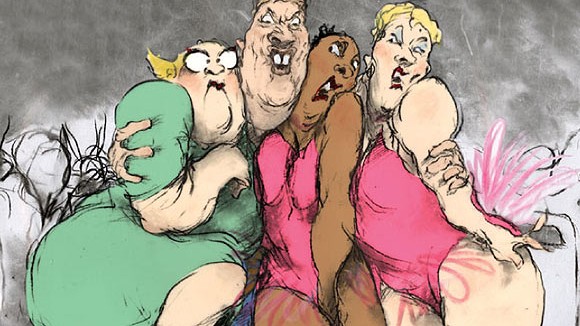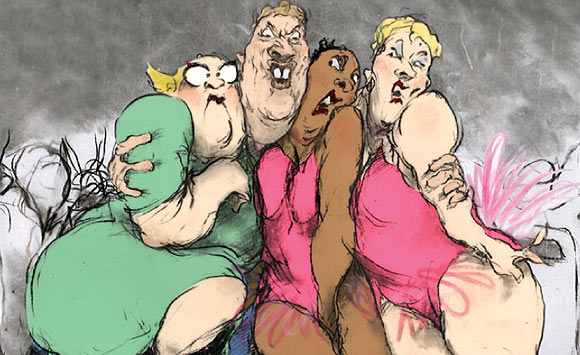

Joanna Quinn Says Disney Animator’s Comments Are “Complete Rubbish,” Animating Women with Emotions is Easy [UPDATED]

Last week we reported on the controversy sparked by Frozen’s head of animation Lino DiSalvo following his comments about the difficulties of showing emotion on Disney’s female characters due to the fact that they have to be kept ‘pretty.’ Besides the Internet reaction, DiSalvo’s comments generated mainstream media attention, including articles in Slate, NY Mag and the UK’s Independent.
In the Independent, Joanna Quinn, one of the most respected British animators and filmmakers, labeled DiSalvo’s comments “complete rubbish.” Quinn, who has won four BAFTAs, two Emmys, and two Oscar nominations, knows a thing or two about animating women. For years, she has animated impeccable and robust performances featuring all types of characters, but especially women. Quinn went on to say:
“It’s not at all hard to draw women showing emotions. The only challenge is the notion of beauty. It’s really hard to inject lots of emotion because you’re always trying to keep them [as] this sort of shiny, lovely character. I am looking for strong female characters that are not always gorgeous.”
The Disney Company has responded to DiSalvo’s comments as well. A company spokesperson issued a statement to TheWrap.com:
“Animation is an intricate and complex art form. These comments were recklessly taken out of context. As part of a roundtable discussion, the animator was describing some technical aspects of CG animation and not making a general comment on animating females versus males or other characters.”
Three days after DiSalvo’s comments blew up online, Dan Sarto, publisher of Animation World Network, published a laudatory article about the animators of Frozen. In the piece, entitled “The Animation of Disney’s Frozen: Striving to Capture the Performance”, Sarto avoided any mention of the controversy, but featured DiSalvo’s thoughts prominently. DiSalvo talked about his approach to character animation with AWN:
“In Tangled, we broke a wall down. Acting-wise, having Glen [Keane] there to push you to find the truth in what you’re caricaturing, we all learned that on the film. I started Frozen with that knowledge. I learned that all on Tangled. But now, it’s a finely sharpened tool instead of a blunt instrument. When Idina Menzel [the voice of Elsa] came in and we showed her two sequences in particular, she paid us the ultimate compliment. She said, ‘What you guys are doing here, some of the great actors, I don’t see it in their performance.’ She noticed little furrowed brows, wrinkles, eye tension, pulsation in the lips, the breathing.”
[UPDATE—Mon 11:50pm ET] Time magazine has published this piece about the discussion that has started after DiSalvo’s comments. They spoke with Brave director Brenda Chapman, who told the publication: “My immediate reaction was that I was absolutely appalled that anyone would say that.”
Filmmaker and USC professor Christine Panushka told Time that while believable humans are always a challenge to animate, it’s odd to suggest that a woman character would be more difficult than a man because “in terms of skeletons and muscles and how we move, they’re the same.”
[UPDATE #2] Brenda Chapman wrote in the comments section of this Indiewire post that Time misquoted her and took her comments out of context. Chapman said:
I couldn’t agree with your article more! As was DiSalvo’s quote, my comments were taken out of context, as well. It’s very disheartening, the lack of integrity that goes into some reporting. The article in question was a jumble of out of context thoughts and quotes and in the end, didn’t really come to a point.
I would very much like to set the record straight in regards to my reaction to DiSalvo’s quote. If she had continued on with my own quote of my initial reaction of being “appalled”, it would have gone against the type of article she wanted to write. I continued on to say that then I put his quote in the context of what he was really discussing, which were the characters specifically in FROZEN. And it made perfect sense. The two characters, I believe, are sisters (what I gleaned from the trailer) – maybe even twins – I don’t know because I have not yet seen it. Of course, if they look so much alike, it would be difficult to give them individual expressions and make them feel like different people. I was actually trying to defend the poor guy! His only mistake was to use the word “pretty” instead of “appealing”… which I have no doubt was his meaning behind it. As with the TIME article, my words have been taken out of context way too often – so I did recognize it in DiSalvo’s.
My other comments were about the industry in general needing more variety in female characters – both physically and character personality – and NOT at Frozen, which I am very much looking forward to seeing.

.png)